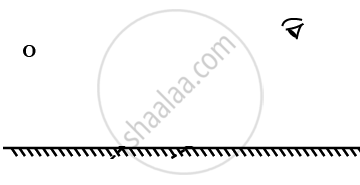Advertisements
Advertisements
Question
How many images will be formed when an object is placed between two parallel plane mirrors with their reflecting surfaces facing each other? Why do more distant images appear fainter?
Solution
Angle between two mirrors facing each other = θ = 0°
No. of. images formed = n = `360^circ/theta = 360^circ/0 = ∞`
So, infinite number of images are formed when an object is placed between two parallel plane mirrors with their reflecting surfaces facing each other.
More distant images appear fainter when two plane mirror with their reflecting surfaces facing each other because,
After every successive reflection, some amount of light energy is absorbed. Thus luminosity of images goes on decreasing and hence they appear fainter.
APPEARS IN
RELATED QUESTIONS
The following diagram shows a point object O placed in front of a plane mirror. Take two rays from the point O and show how the image of O is formed and seen by the eye.

Explain the following term:
Angle of incidence
Draw diagram/diagrams to show them.
Figure shows an incident ray AO and the normal ON on a plane mirror. The angle which the incident ray AO makes with mirror is 30°. (a) Find the angle of incidence. (b) Draw the reflected ray and then find the angle between the incident and reflected rays.

Draw diagrams to show the difference between regular and irregular reflection.
An object 3 cm high produces a real image 4.5 cm high when placed at a distance of 20 cm from a concave mirror. Calculate:
- the position of image
- focal length of the concave mirror.
An object is placed in front of a convex mirror of focal length 25 cm. By scale, a drawing shows the formation of image and states the nature of image.
Given that v = 10 cm.
Match the following:
| 1. | Vegetable oil | a. | Transparent |
| 2. | Glass | b. | Translucent |
| 3. | Wood | c. | Waterproof |
| 4. | Aluminum foil | d. | Opaque |
______ through which light can pass partially.
Part of the eye which controls the entering of light is called
Plane mirrors are used as looking glass, to reflect light on objects and in periscopes.
